A Social Network Analysis of International Creative Goods Flow
Abstract
1. Introduction
2. Literature Review
3. Materials and Methods
3.1. Data
3.2. Analysis
4. Results
5. Discussion and Conclusions
6. Limitations and Future Studies
Author Contributions
Funding
Informed Consent Statement
Data Availability Statement
Conflicts of Interest
References
- Florida, R. The flight of the creative class: The new global competition for talent. Lib. Educ. 2006, 92, 22–29. [Google Scholar]
- UNCTAD. Creative Economy Report; UNCTAD: Geneva, Switzerland, 2010. [Google Scholar]
- EC. Commission Staff Working Document-Analysis of the Consultation launched by the Green Paper on “Unlocking the Potential of Cultural and Creative Industries”; EC: Brussels, Belgium, 2010. [Google Scholar]
- UNCTAD. Creative Economy Statistics; UNCTAD: Geneva, Switzerland, 2018. [Google Scholar]
- Niu, J. A study of the influencing factors of the export trade of Beijing’s cultural creativity industry. Am. J. Ind. Bus. Manag. 2017, 7, 69–77. [Google Scholar] [CrossRef][Green Version]
- UNCTAD. Creative Economy Report 2008: The Challenge of Assessing the Creative Economy Towards Informed Policy Making; United Nations: Geneva, Switzerland, 2008. [Google Scholar]
- Fomenko, T.; Bilotserkovets, M.; Klochkova, T.; Statsenko, O.; Sbruieva, A.; Kozlova, O.; Kozlov, D. Overcoming Barriers in Intercultural Communication: A Case Study on Agricultural Idioms in English, Ukrainian and Chinese. Acad. J. Interdiscip. Stud. 2020, 9, 157–166. [Google Scholar] [CrossRef]
- Aage, T.; Belussi, F. From fashion to design: Creative networks in industrial districts. Ind. Innov. 2008, 15, 475–491. [Google Scholar] [CrossRef]
- Barrère, C.; Delabruyère, S. Intellectual property rights on creativity and heritage: The case of the fashion industry. Eur. J. Law Econ. 2011, 32, 305–339. [Google Scholar] [CrossRef]
- Beck, J. The sales effect of word of mouth: A model for creative goods and estimates for novels. J. Cult. Econ. 2007, 31, 5–23. [Google Scholar] [CrossRef]
- Benita, F.; Urzúa, C.M. Efficient creativity in Mexican metropolitan areas. Econ. Model. 2018, 71, 25–33. [Google Scholar] [CrossRef]
- Černevičiūtė, J.; Strazdas, R. Teamwork management in Creative industries: Factors influencing productivity. Entrep. Sustain. Issues 2018, 6, 503–516. [Google Scholar] [CrossRef]
- Clement, J.; Shipilov, A.; Galunic, C. Brokerage as a Public Good: The Externalities of Network Hubs for Different Formal Roles in Creative Organizations. Adm. Sci. Q. 2017, 63, 251–286. [Google Scholar] [CrossRef]
- Dong, C.V.; Truong, H.Q. The determinants of creative goods exports: Evidence from Vietnam. J. Cult. Econ. 2019, 44, 281–308. [Google Scholar] [CrossRef]
- Bhattacharya, K.; Mukherjee, G.; Saramäki, J.; Kaski, K.; Manna, S.S. The international trade network: Weighted network analysis and modelling. J. Stat. Mech. Theory Exp. 2008, 2008, P02002. [Google Scholar] [CrossRef]
- De Andrade, R.L.; Rêgo, L.C. The use of nodes attributes in social network analysis with an application to an international trade network. Phys. Stat. Mech. Its Appl. 2018, 491, 249–270. [Google Scholar] [CrossRef]
- De Benedictis, L.; Nenci, S.; Santoni, G.; Tajoli, L.; Vicarelli, C. Network analysis of world trade using the BACI-CEPII dataset. Glob. Econ. J. 2014, 14, 287–343. [Google Scholar] [CrossRef]
- Smith, D.A.; White, D.R. Structure and dynamics of the global economy: Network analysis of international trade 1965–1980. Soc. Forces 1992, 70, 857–893. [Google Scholar] [CrossRef]
- Petridis, N.E.; Petridis, K.; Stiakakis, E. Global e-waste trade network analysis. Resour. Conserv. Recycl. 2020, 158, 104742. [Google Scholar] [CrossRef]
- Rassekh, F. The interplay of international trade, economic growth and income convergence: A brief intellectual history of recent developments. J. Int. Trade Econ. Dev. 2004, 13, 371–395. [Google Scholar] [CrossRef]
- UNESCO. The Globalisation Of Cultural Trade: A Shift in Consumption-International Flows of Cultural Goods and Services 2004–2013; UNESCO: Quebec, QC, Canada, 2016. [Google Scholar]
- Cerisola, S.; Panzera, E. Cultural and Creative Cities and Regional Economic Efficiency: Context Conditions as Catalyzers of Cultural Vibrancy and Creative Economy. Sustainability 2021, 13, 7150. [Google Scholar] [CrossRef]
- Howkins, J. The Creative Economy: How People Make Money from Ideas; Penguin: London, UK, 2002. [Google Scholar]
- Orefice, G.; Santoni, G. Exporting creative and cultural products: Birthplace diversity matters! World Econ. 2018, 41, 1867–1887. [Google Scholar] [CrossRef]
- European Union. Mapping the Creative Value Chains-A study on the Economy of Culture in the Digital Age; European Union: Luxembourg, Luxembourg, 2017. [Google Scholar]
- Horobets, O. The Book Trade as a Subcategory of the International trade in Cultural Goods of the European Union in the Creative Economy Sector: A Statistical Analysis; Access Press: Saint Paul, MN, USA, 2020; pp. 353–363. [Google Scholar]
- Meyer, J.W. Globalization: Theory and trends. Int. J. Comp. Sociol. 2007, 48, 261–273. [Google Scholar] [CrossRef]
- Harris, R.G. Globalization, trade, and income. Can. J. Econ./Revue Canadienne D’Economique 1993, 26, 755–776. [Google Scholar] [CrossRef]
- Chen, G.-M. The impact of new media on intercultural communication in global context. China Media Res. 2012, 8, 1–10. [Google Scholar]
- Kluver, R. Globalization, informatization, and intercultural communication. Am. Commun. J. 2000, 3. [Google Scholar]
- Holmes, P. Intercultural Communication in the Global Workplace, Critical Approaches. In The International Encyclopedia of Intercultural Communication; John Wiley Sons: New York, NY, USA, 2017; pp. 1–16. [Google Scholar]
- Arribas, I.; Pérez, F.; Tortosa-Ausina, E. Measuring Globalization of International Trade: Theory and Evidence. World Dev. 2009, 37, 127–145. [Google Scholar] [CrossRef][Green Version]
- Martell, L. The third wave in globalization theory. Int. Stud. Rev. 2007, 9, 173–196. [Google Scholar] [CrossRef]
- Clark, R.; Beckfield, J. A New Trichotomous Measure of World-system Position Using the International Trade Network. Int. J. Comp. Sociol. 2009, 50, 5–38. [Google Scholar] [CrossRef]
- Chung, J.E. Mapping International Film Trade: Network Analysis of International Film Trade Between 1996 and 2004. J. Commun. 2011, 61, 618–640. [Google Scholar] [CrossRef]
- Cattani, G.; Ferriani, S. A core/periphery perspective on individual creative performance: Social networks and cinematic achievements in the Hollywood film industry. Organ. Sci. 2008, 19, 824–844. [Google Scholar] [CrossRef]
- Florida, R.; Mellander, C.; King, K. The Global Creativity Index 2015; Martin Prosperity Institute: Toronto, ON, Canada, 2015. [Google Scholar]
- DiPietro, W.R.; Anoruo, E. Creativity, innovation, and export performance. J. Policy Modeling 2006, 28, 133–139. [Google Scholar] [CrossRef]
- World Bank. World Development Indicators; World Bank: Washington, DC, USA, 2020. [Google Scholar]
- WEF. The Global Competitiveness Report 2014–2015; WEF: Geneva, Switzerland, 2014. [Google Scholar]
- UNESCO. Dataset: Science, Technology and Innovation; UNESCO: Quebec, QC, Canada, 2021. [Google Scholar]
- Marin, A.; Wellman, B. Social network analysis: An introduction. SAGE Handb. Soc. Netw. Anal. 2011, 11, 25. [Google Scholar]
- Nam, Y.; Barnett, G.A. Globalization of technology: Network analysis of global patents and trademarks. Technol. Forecast. Soc. Chang. 2011, 78, 1471–1485. [Google Scholar] [CrossRef]
- Choi, J.H.; Barnett, G.A.; CHON, B.S. Comparing world city networks: A network analysis of Internet backbone and air transport intercity linkages. Glob. Netw. 2006, 6, 81–99. [Google Scholar] [CrossRef]
- Borgatti, S.P.; Everett, M.G.; Johnson, J.C. Analyzing Social Networks; Sage: Thousand Oaks, CA, USA, 2013. [Google Scholar]
- Park, J.H.; Lee, C.; Yoo, C.; Nam, Y. An analysis of the utilization of Facebook by local Korean governments for tourism development and the network of smart tourism ecosystem. Int. J. Inf. Manag. 2016, 36, 1320–1327. [Google Scholar] [CrossRef]
- Nam, Y. Institutional network structure of corporate stakeholders regarding global corporate social responsibility issues. Qual. Quant. 2015, 49, 1063–1080. [Google Scholar] [CrossRef]
- Forbes. Singapore’s Bet on a Creative Economy Hits the Road; Forbes: Washington, DC, USA, 2015. [Google Scholar]
- Samovar, L.A.; Porter, R.E.; McDaniel, E.R. Communication between Cultures; Wadsworth/Cengage Learning: Belmont, CA, USA, 2010. [Google Scholar]
- Xu, M.; Tian, C. Cultural deformations and reformulations: A case study of Disney’s Mulan in English and Chinese. Crit. Arts 2013, 27, 182–210. [Google Scholar] [CrossRef]
- Gere, C. New Media Art and the Gallery in the Digital Age. Tate Papers. 2004. Available online: https://www.tate.org.uk/research/publications/tate-papers/02/new-media-art-and-the-gallery-in-the-digital-age (accessed on 1 March 2022).
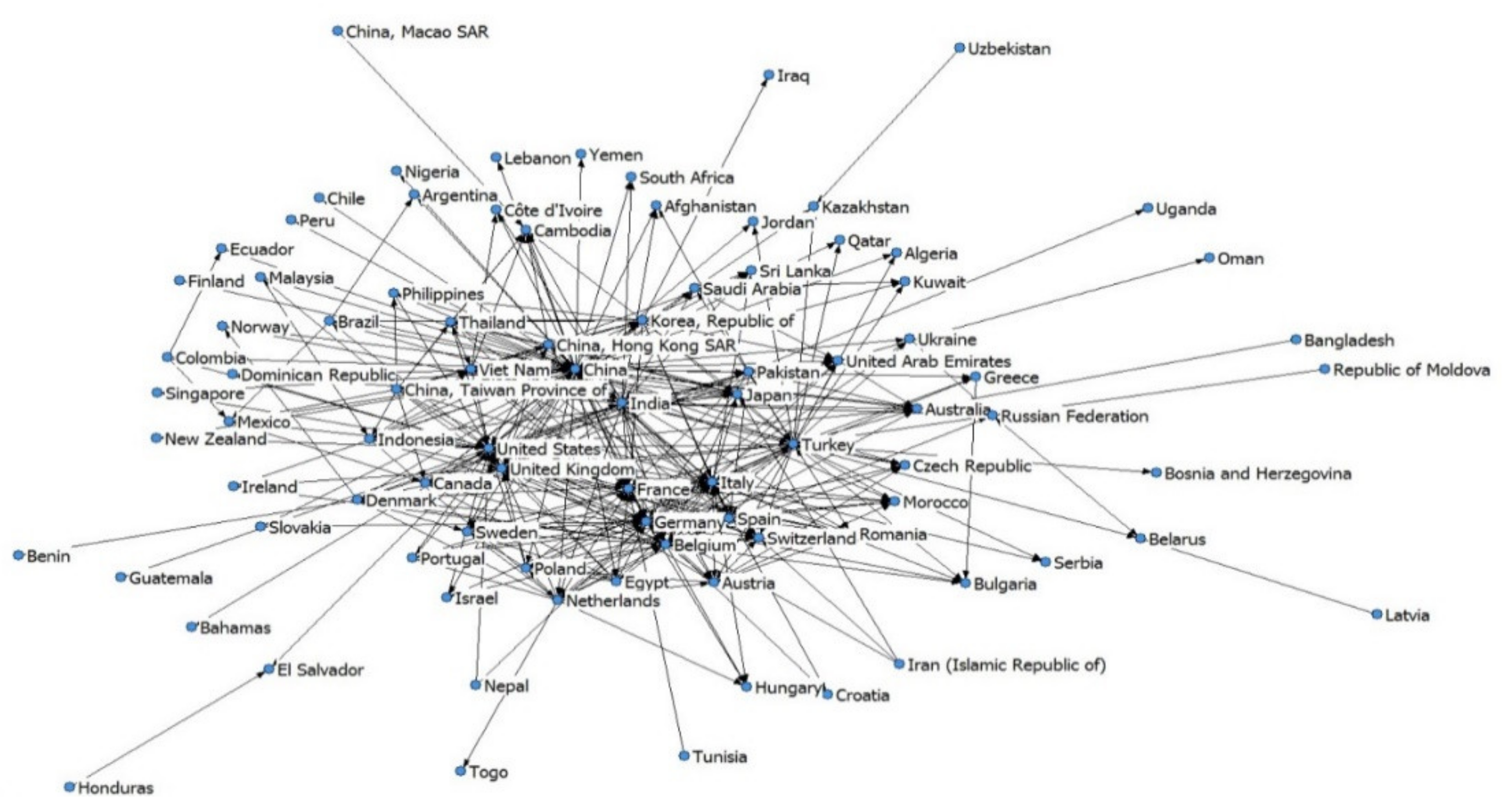
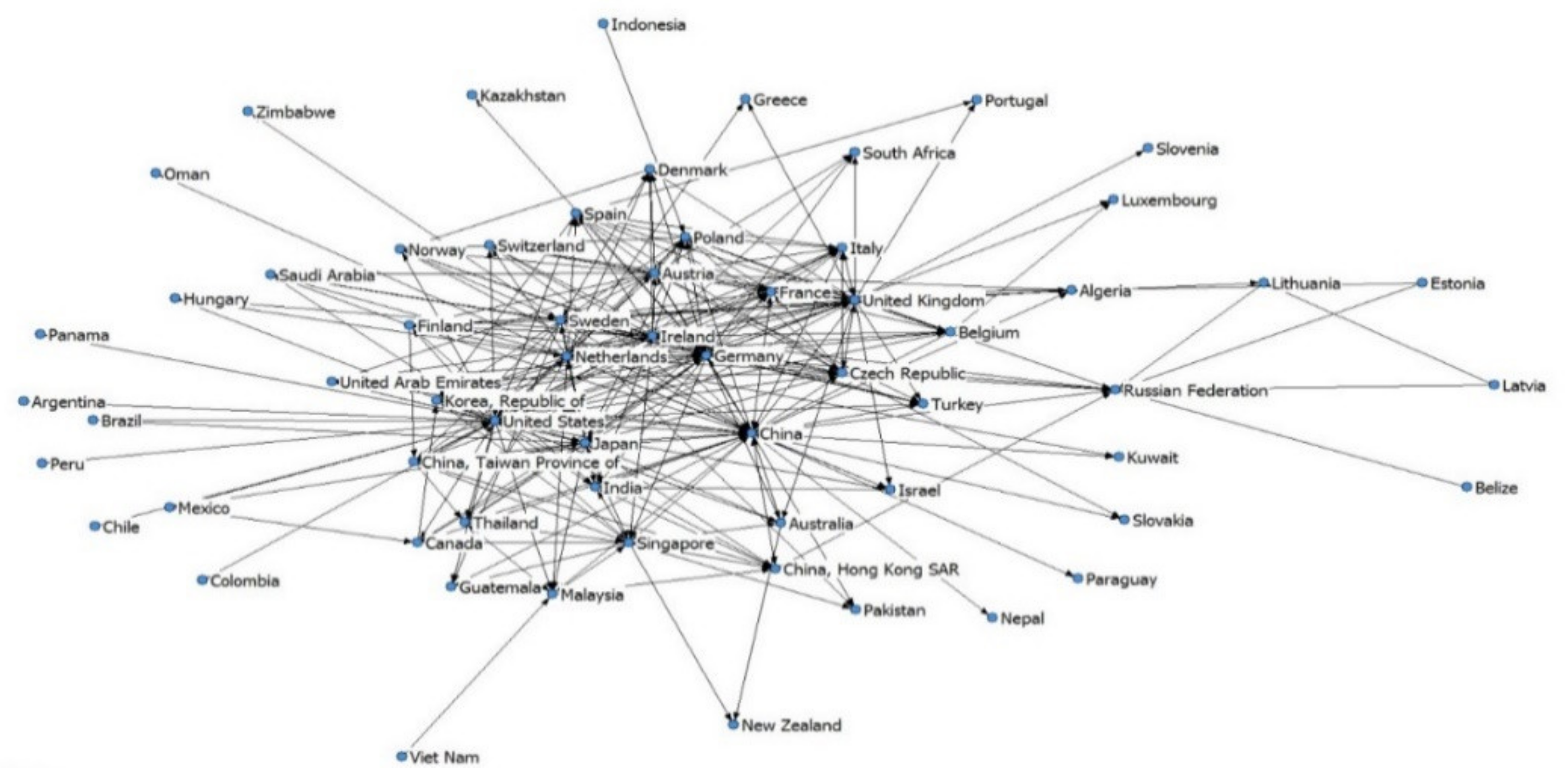
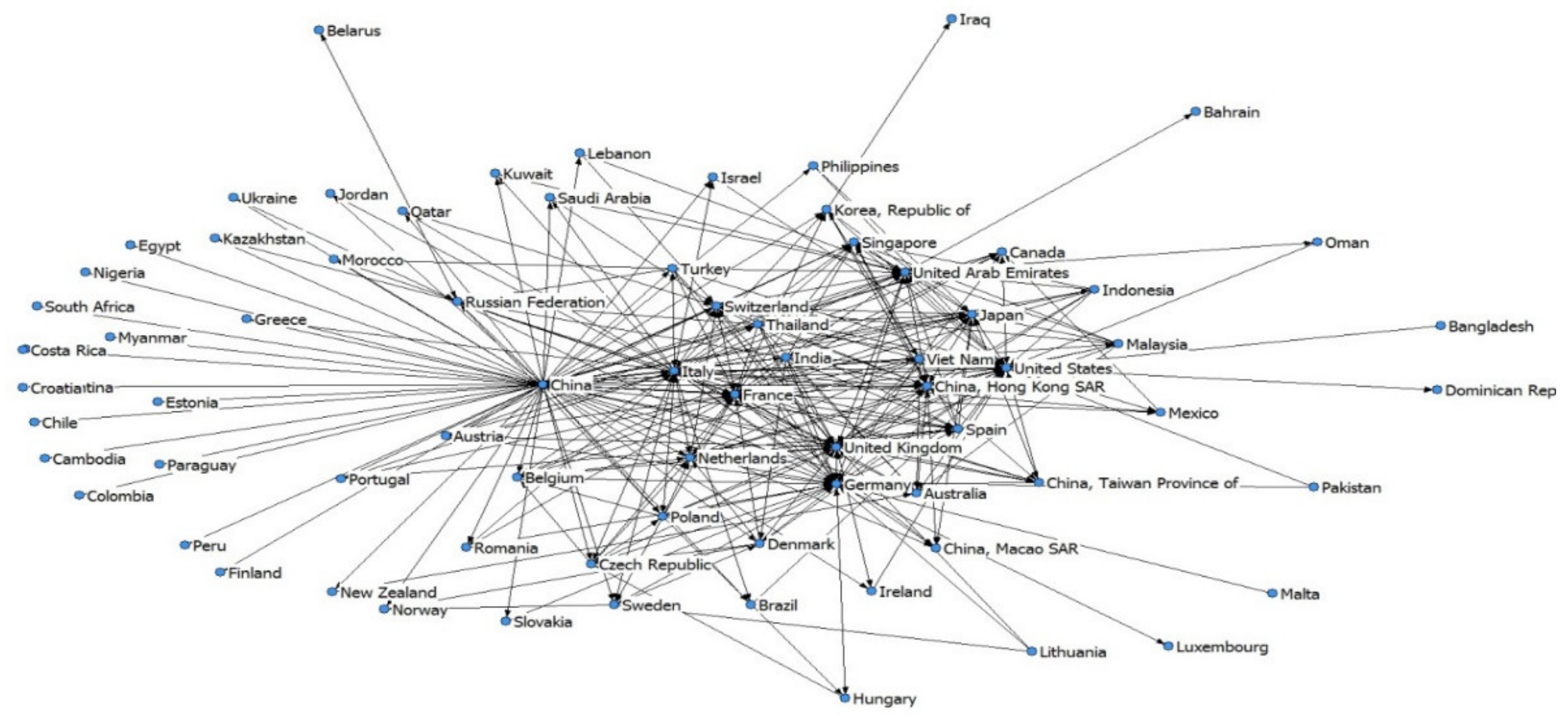
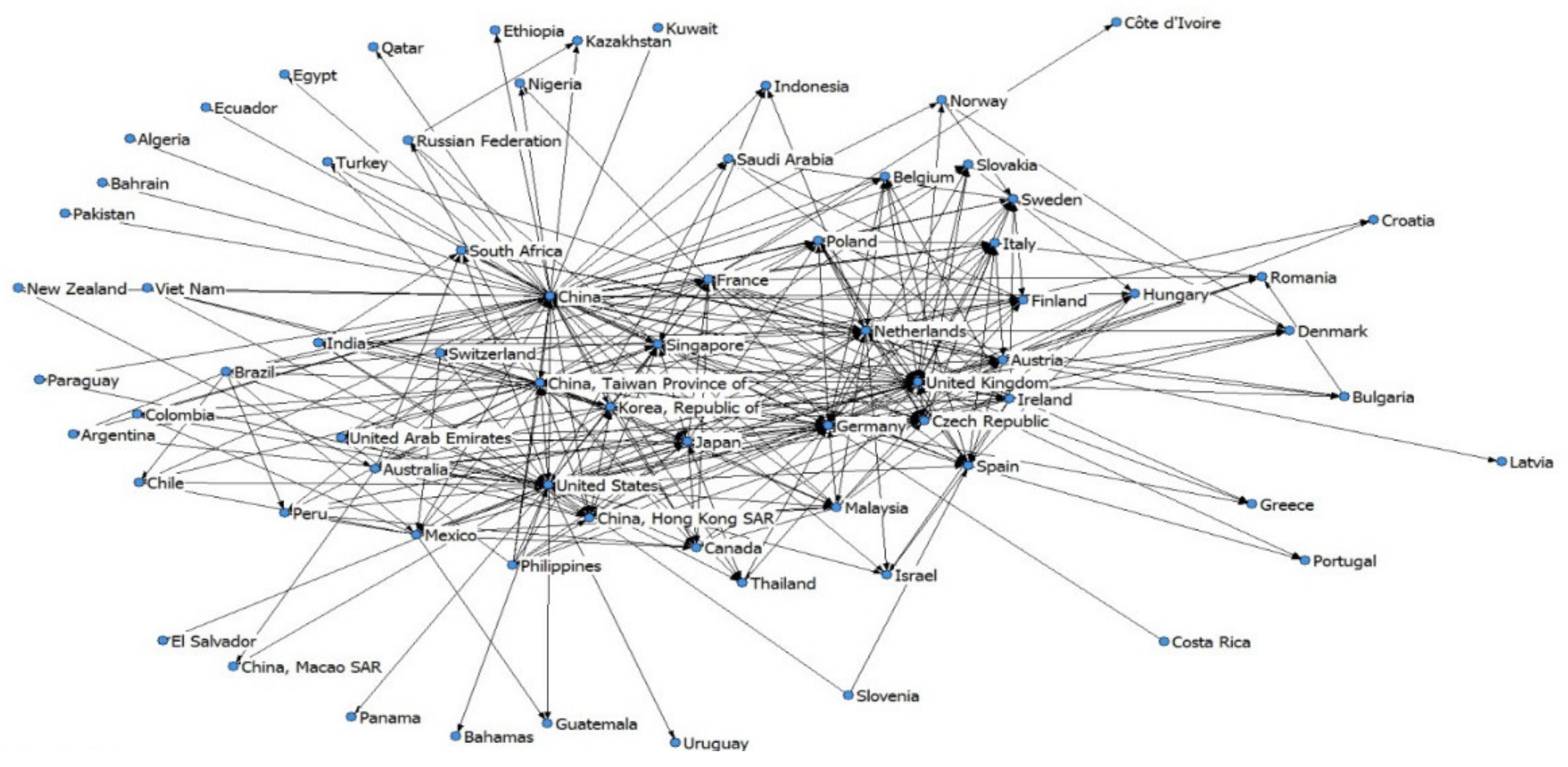
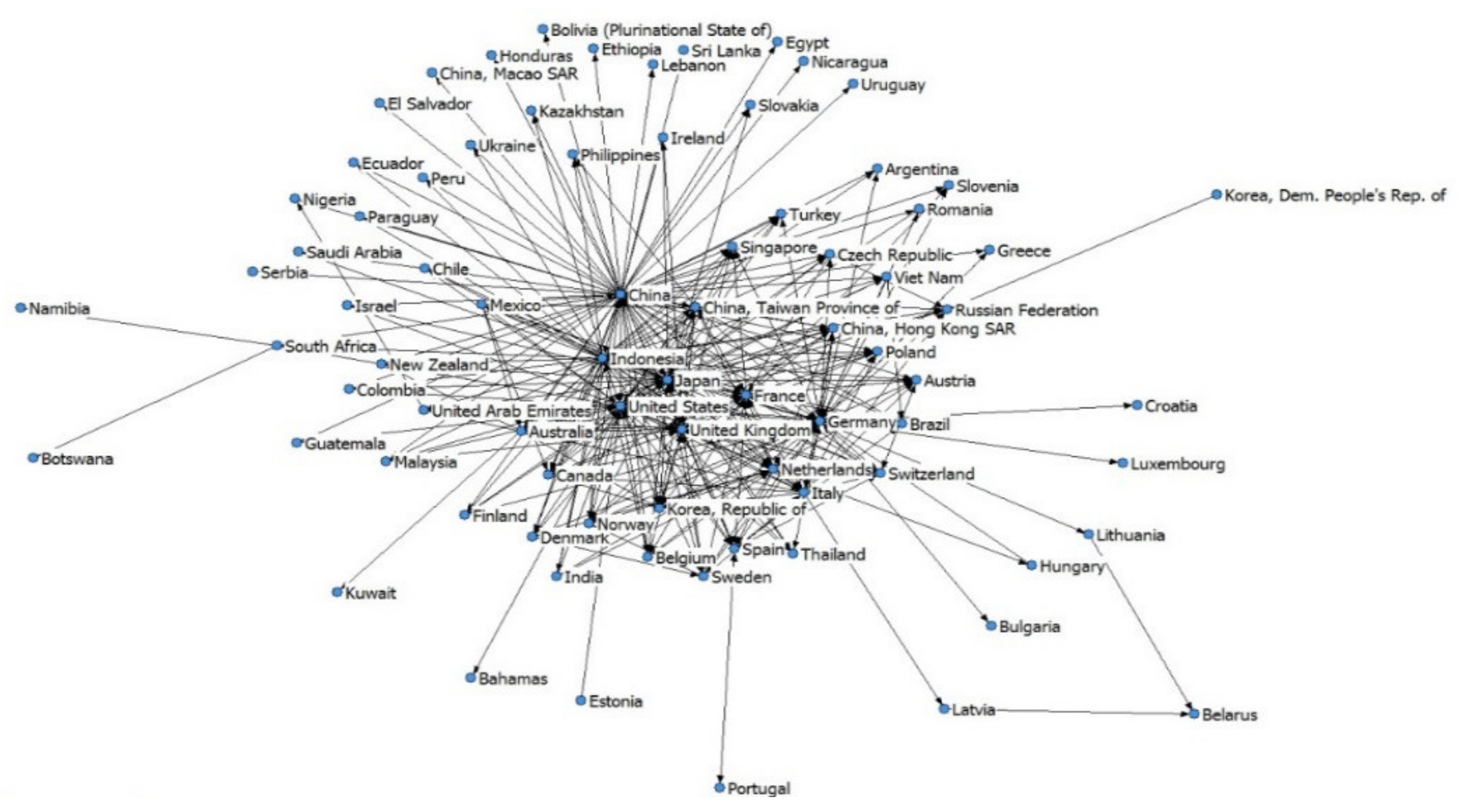
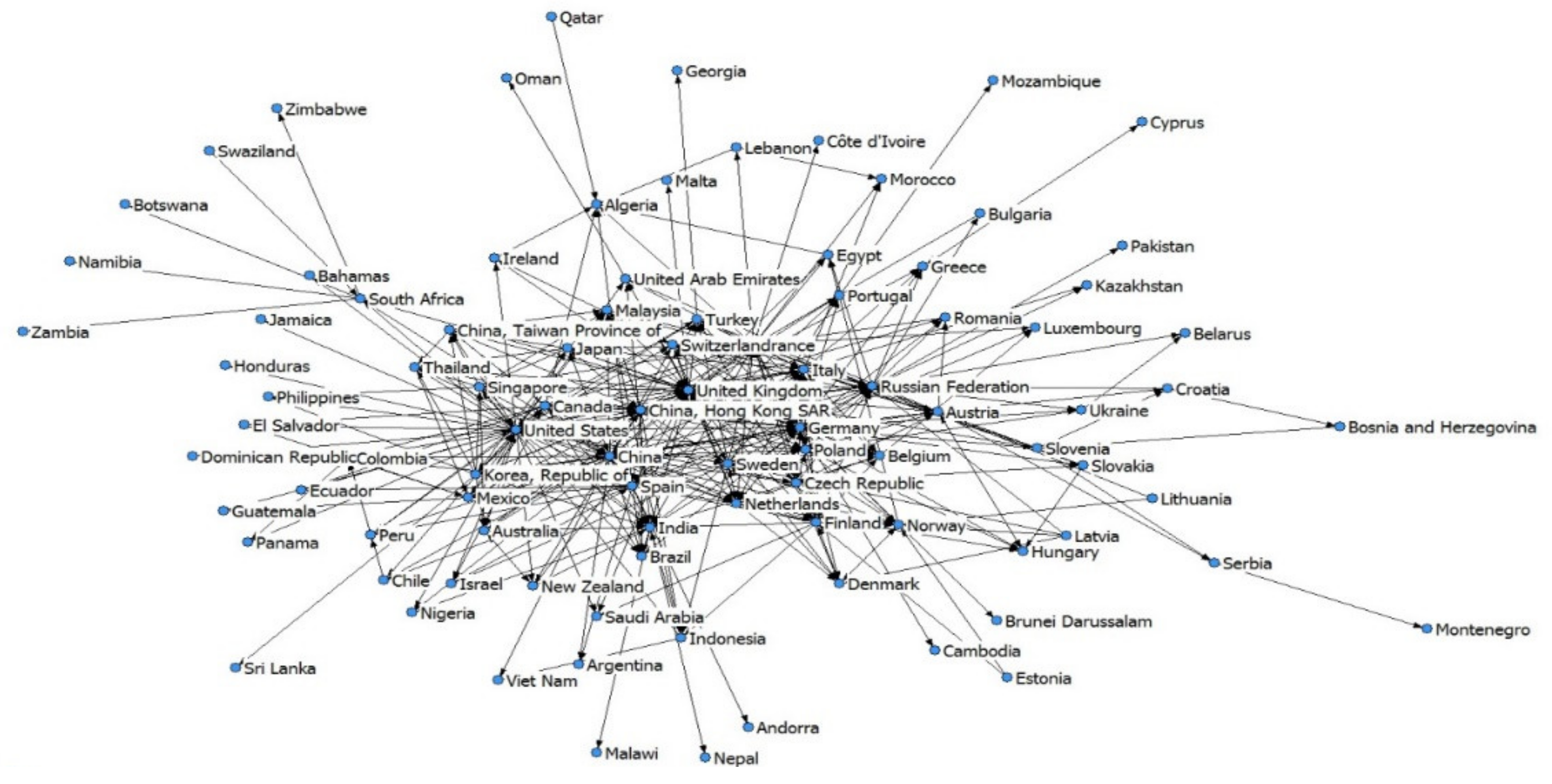
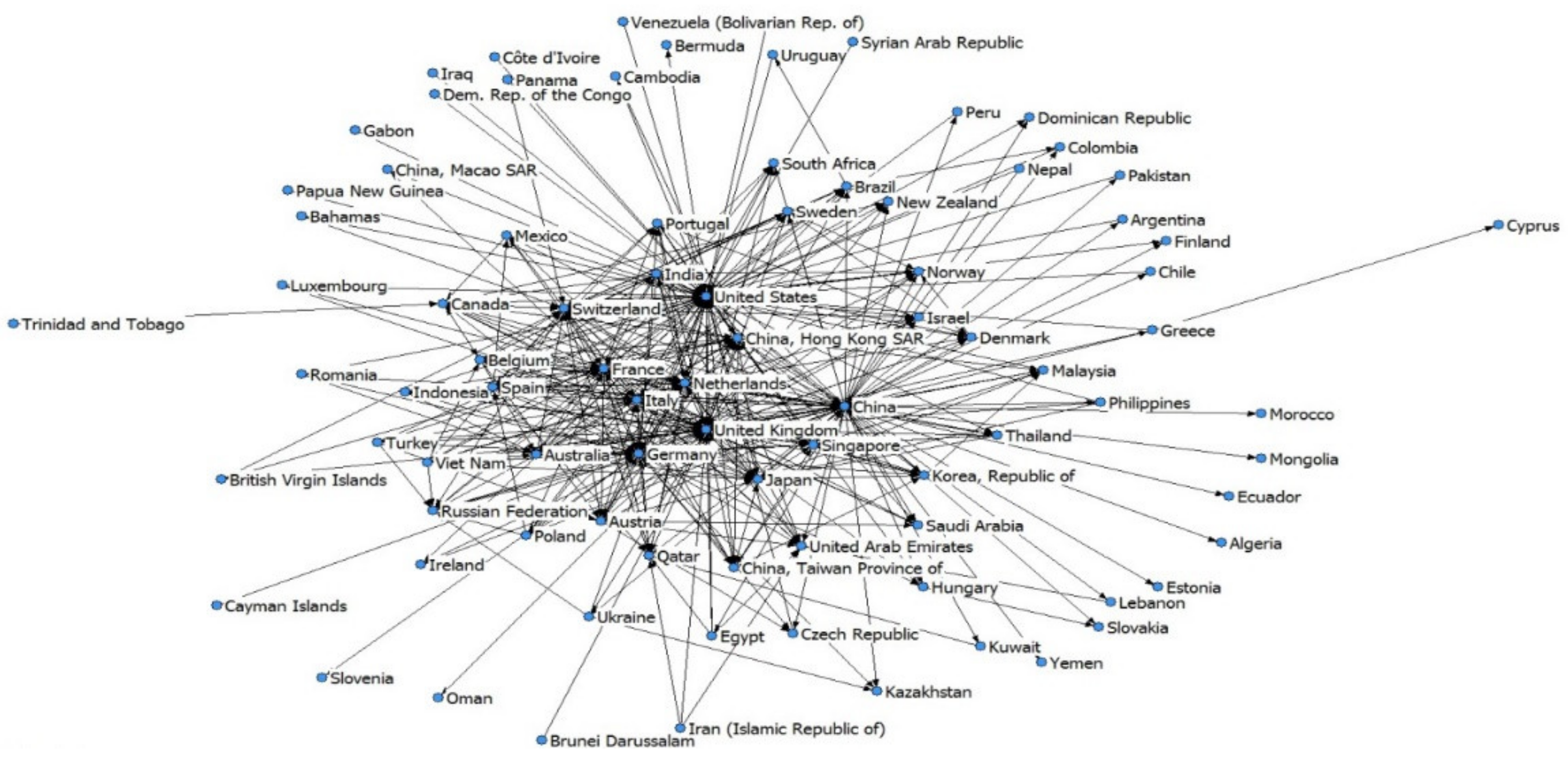
| Creative Goods | Composition |
|---|---|
| Art crafts | carpets, celebrations, paperware, wicker-ware, yarn, and other art crafts |
| Audiovisuals | film, CDs, DVDs, and tapes |
| Design | architecture, fashion, glassware, interior, jewelry, and toys |
| New media | recorded media and video games |
| Performing arts | musical instruments and printed music |
| Publishing | books, newspapers, and other printed matter |
| Visual arts | antiques, painting, photography, and sculpture |
| Measure | Definition |
|---|---|
| In-degree centrality | Number of directional links to the country from other countries (creative goods imports) |
| Out-degree centrality | Number of directional links from the country to other countries (creative goods exports) |
| Betweenness centrality | The extent to which relationships are controlled or mediated between countries but are not directly connected |
| Eigenvector centrality | The extent to which the number and importance of directly connected countries are taken into account |
| Rank | Country | Out-Degree | Country | In-Degree | Country | Eigenvector | Country | Betweenness |
|---|---|---|---|---|---|---|---|---|
| 1 | China | 16,061,570,048 | US | 7,493,210,112 | China | 0.697 | US | 2027.125 |
| 2 | India | 1,909,445,248 | Cambodia | 2,158,286,848 | US | 0.614 | France | 1740.271 |
| 3 | Turkey | 1,900,714,880 | UK | 2,002,855,552 | Cambodia | 0.178 | Canada | 1301.132 |
| 4 | Belgium | 1,407,558,528 | Germany | 1,777,264,640 | China, Hong Kong | 0.148 | Spain | 1232.149 |
| 5 | Republic of Korea | 1,282,637,952 | China, Hong Kong | 1,369,909,632 | Japan | 0.109 | Thailand | 1036.914 |
| 6 | China, Taiwan | 1,152,371,840 | Japan | 1,241,140,736 | Canada | 0.097 | Switzerland | 902.827 |
| 7 | US | 1,000,713,216 | Canada | 1,070,058,688 | UK | 0.096 | Netherlands | 801.604 |
| 8 | Germany | 983,454,144 | France | 1,048,219,328 | India | 0.091 | Germany | 774.068 |
| 9 | Italy | 918,516,096 | Vietnam | 1,032,430,528 | Germany | 0.073 | China | 715.197 |
| 10 | Netherlands | 752,305,600 | Italy | 1,020,625,216 | Vietnam | 0.073 | Belgium | 690.739 |
| 11 | China, Hong Kong | 729,027,648 | China | 755,893,376 | Turkey | 0.066 | UK | 675.701 |
| 12 | Vietnam | 599,212,096 | Indonesia | 673,364,416 | China, Taiwan | 0.057 | Indonesia | 650.113 |
| 13 | Pakistan | 526,449,920 | Mexico | 655,742,400 | Italy | 0.055 | United Arab Emirates | 634.752 |
| 14 | France | 495,232,704 | Spain | 644,993,984 | Mexico | 0.053 | Italy | 583.255 |
| 15 | Thailand | 405,045,856 | Netherlands | 617,443,200 | France | 0.051 | Australia | 535.805 |
| 16 | Egypt | 384,593,664 | Russian Federation | 570,973,888 | Brazil | 0.050 | South Africa | 505.319 |
| 17 | Japan | 332,182,144 | Belgium | 531,786,656 | Netherlands | 0.044 | India | 462.874 |
| 18 | Spain | 319,013,312 | Australia | 511,275,616 | Belgium | 0.043 | Japan | 430.095 |
| 19 | UK | 281,166,112 | Brazil | 501,899,200 | Republic of Korea | 0.040 | Turkey | 403.338 |
| 20 | Austria | 256,463,856 | Turkey | 470,854,368 | Australia | 0.036 | Republic of Korea | 388.940 |
| Rank | Country | Out-Degree | Country | In-Degree | Country | Eigenvector | Country | Betweenness |
|---|---|---|---|---|---|---|---|---|
| 1 | US | 3,365,296,128 | China | 3,188,622,336 | China | 0.532 | Thailand | 2494.414 |
| 2 | Germany | 2,970,414,080 | Germany | 2,173,686,016 | US | 0.418 | France | 2273.659 |
| 3 | Singapore | 1,923,347,840 | UK | 1,574,900,992 | Singapore | 0.394 | Germany | 1585.299 |
| 4 | Ireland | 1,885,148,928 | France | 1,293,718,656 | Germany | 0.267 | Netherlands | 1373.947 |
| 5 | Japan | 1,857,090,944 | Russian Federation | 1,219,902,336 | Japan | 0.239 | Switzerland | 1313.611 |
| 6 | Netherlands | 1,734,253,568 | Thailand | 1,180,880,512 | Canada | 0.192 | South Africa | 1266.096 |
| 7 | Austria | 1,398,298,624 | US | 1,121,685,248 | UK | 0.166 | US | 1194.692 |
| 8 | UK | 1,367,827,584 | Canada | 1,009,545,024 | Ireland | 0.165 | Canada | 1163.477 |
| 9 | China | 1,103,637,632 | Republic of Korea | 866,400,128 | Netherlands | 0.159 | Austria | 996.696 |
| 10 | Malaysia | 984,617,472 | India | 855,289,792 | France | 0.149 | UK | 979.333 |
| 11 | France | 844,499,840 | Netherlands | 819,636,224 | Austria | 0.140 | Mexico | 631.325 |
| 12 | Sweden | 841,530,944 | Austria | 744,487,040 | Thailand | 0.112 | Spain | 621.070 |
| 13 | Poland | 771,347,328 | Italy | 610,935,040 | Republic of Korea | 0.098 | Singapore | 617.244 |
| 14 | Czech Republic | 640,172,672 | Japan | 538,265,152 | Mexico | 0.090 | Republic of Korea | 547.183 |
| 15 | Finland | 609,197,888 | Spain | 526,228,576 | Poland | 0.089 | Sweden | 523.770 |
| 16 | Estonia | 568,691,776 | China, Hong Kong | 459,567,648 | India | 0.088 | China | 507.138 |
| 17 | Mexico | 433,760,064 | Belgium | 447,864,832 | Malaysia | 0.086 | Ireland | 419.263 |
| 18 | China, Taiwan | 393,031,200 | Singapore | 441,800,640 | China, Hong Kong | 0.083 | Russian Federation | 389.642 |
| 19 | China, Hong Kong | 283,680,192 | China, Taiwan | 440,890,784 | China, Taiwan | 0.070 | Italy | 387.374 |
| 20 | Italy | 214,082,016 | United Arab Emirates | 434,049,696 | Italy | 0.069 | Belgium | 380.523 |
| Rank | Country | Out-Degree | Country | In-Degree | Country | Eigenvector | Country | Betweenness |
|---|---|---|---|---|---|---|---|---|
| 1 | China | 119,897,923,584 | US | 60,853,317,632 | China | 0.675 | Canada | 1404.048 |
| 2 | Italy | 25,793,767,424 | China, Hong Kong | 27,192,170,496 | US | 0.592 | US | 1152.574 |
| 3 | France | 16,771,828,736 | Germany | 17,007,591,424 | China, Hong Kong | 0.246 | France | 1118.858 |
| 4 | India | 13,329,161,216 | UK | 16,831,697,920 | Japan | 0.148 | Netherlands | 717.989 |
| 5 | Germany | 11,397,925,888 | France | 14,541,173,760 | France | 0.134 | UK | 665.190 |
| 6 | US | 9,513,821,184 | Japan | 14,304,950,272 | Italy | 0.126 | Thailand | 584.471 |
| 7 | Vietnam | 8,152,137,216 | Switzerland | 13,819,928,576 | UK | 0.121 | Switzerland | 553.965 |
| 8 | China, Hong Kong | 6,906,440,192 | United Arab Emirates | 13,409,119,232 | Germany | 0.118 | Spain | 541.513 |
| 9 | Switzerland | 6,341,344,256 | Italy | 8,377,286,656 | Canada | 0.082 | Mexico | 531.398 |
| 10 | Thailand | 6,012,520,960 | Canada | 7,653,496,832 | India | 0.074 | Austria | 519.321 |
| 11 | Malaysia | 5,105,714,176 | Singapore | 6,264,443,904 | Mexico | 0.070 | Germany | 515.249 |
| 12 | UK | 5,023,371,776 | Russian Federation | 5,719,577,600 | Vietnam | 0.066 | Singapore | 493.706 |
| 13 | Poland | 4,225,331,200 | Australia | 5,474,208,256 | Switzerland | 0.061 | South Africa | 489.462 |
| 14 | Spain | 4,129,943,808 | Netherlands | 5,247,385,088 | Australia | 0.054 | United Arab Emirates | 488.387 |
| 15 | Mexico | 3,737,477,888 | Spain | 5,222,945,792 | United Arab Emirates | 0.050 | Republic of Korea | 416.092 |
| 16 | United Arab Emirates | 3,526,600,960 | China | 4,952,588,288 | Russian Federation | 0.048 | China | 411.657 |
| 17 | Indonesia | 3,508,356,608 | Belgium | 4,887,282,688 | Spain | 0.046 | Belgium | 391.184 |
| 18 | Netherlands | 2,987,886,592 | Republic of Korea | 4,499,047,424 | Thailand | 0.040 | Australia | 390.853 |
| 19 | Czech Republic | 2,964,043,776 | Austria | 3,826,048,000 | Republic of Korea | 0.039 | Ireland | 353.533 |
| 20 | Turkey | 2,850,425,856 | Mexico | 3,358,569,728 | Netherlands | 0.036 | Italy | 350.939 |
| Rank | Country | Out-Degree | Country | In-Degree | Country | Eigenvector | Country | Betweenness |
|---|---|---|---|---|---|---|---|---|
| 1 | China | 23,594,729,472 | US | 10,120,960,000 | China | 0.692 | France | 2713.160 |
| 2 | China, Taiwan | 5,408,891,904 | China, Hong Kong | 4,904,310,784 | US | 0.573 | Netherlands | 2182.606 |
| 3 | US | 2,108,117,632 | Germany | 3,401,995,264 | China, Hong Kong | 0.222 | Switzerland | 1384.515 |
| 4 | Republic of Korea | 2,010,177,408 | UK | 2,709,358,848 | Japan | 0.189 | US | 1238.217 |
| 5 | Japan | 1,812,998,656 | Japan | 2,582,089,472 | China, Taiwan | 0.167 | Germany | 1099.391 |
| 6 | Germany | 1,670,242,432 | China | 2,157,086,464 | Germany | 0.131 | Canada | 1040.752 |
| 7 | Netherlands | 1,622,292,096 | France | 1,868,595,840 | UK | 0.119 | Spain | 1000.904 |
| 8 | UK | 1,091,910,272 | Netherlands | 1,763,417,216 | Netherlands | 0.096 | China | 866.616 |
| 9 | Malaysia | 955,441,024 | Canada | 1,437,337,344 | Republic of Korea | 0.089 | South Africa | 837.466 |
| 10 | Singapore | 837,566,912 | Poland | 1,257,928,320 | Canada | 0.086 | UK | 717.886 |
| 11 | Ireland | 784,263,360 | Mexico | 1,231,842,560 | France | 0.080 | Australia | 695.545 |
| 12 | France | 768,034,176 | Australia | 986,418,752 | Mexico | 0.066 | Mexico | 669.967 |
| 13 | Austria | 618,859,200 | Singapore | 856,847,040 | Australia | 0.055 | Thailand | 623.616 |
| 14 | Poland | 556,843,648 | Spain | 836,148,224 | United Arab Emirates | 0.044 | Austria | 619.301 |
| 15 | Czech Republic | 531,335,360 | United Arab Emirates | 769,198,080 | Poland | 0.038 | Republic of Korea | 577.525 |
| 16 | China, Hong Kong | 355,453,344 | Italy | 764,402,304 | Singapore | 0.032 | India | 500.116 |
| 17 | Mexico | 348,790,880 | China, Taiwan | 742,029,312 | Malaysia | 0.030 | Denmark | 403.793 |
| 18 | Philippines | 347,563,360 | Austria | 633,031,552 | Russian Federation | 0.030 | China, Hong Kong | 398.575 |
| 19 | Canada | 256,494,640 | Czech Republic | 607,395,776 | India | 0.026 | Ireland | 393.463 |
| 20 | Switzerland | 246,003,712 | India | 563,243,840 | Spain | 0.026 | Belgium | 386.954 |
| Rank | Country | Out-Degree | Country | In-Degree | Country | Eigenvector | Country | Betweenness |
|---|---|---|---|---|---|---|---|---|
| 1 | China | 1,906,418,688 | US | 1,178,285,440 | China | 0.609 | France | 2427.622 |
| 2 | Indonesia | 777,602,048 | Germany | 599,147,328 | US | 0.578 | Canada | 1942.294 |
| 3 | Japan | 540,309,376 | Japan | 431,087,648 | Germany | 0.266 | Germany | 1880.413 |
| 4 | US | 482,800,128 | UK | 292,924,704 | Japan | 0.258 | US | 1834.410 |
| 5 | Germany | 442,753,184 | France | 264,421,680 | Indonesia | 0.250 | China | 1497.683 |
| 6 | Netherlands | 242,337,888 | China | 203,331,440 | Netherlands | 0.125 | Spain | 1426.869 |
| 7 | France | 126,451,752 | Canada | 201,702,160 | UK | 0.122 | Republic of Korea | 1292.332 |
| 8 | China, Taiwan | 109,820,944 | Netherlands | 177,240,096 | France | 0.114 | Netherlands | 1267.471 |
| 9 | Mexico | 90,549,360 | Republic of Korea | 158,171,216 | Canada | 0.111 | UK | 1238.223 |
| 10 | Republic of Korea | 82,165,208 | Australia | 126,576,816 | Republic of Korea | 0.083 | Thailand | 951.708 |
| 11 | UK | 74,785,824 | Italy | 117,319,984 | Mexico | 0.076 | Switzerland | 828.376 |
| 12 | Italy | 73,087,904 | Brazil | 103,672,144 | Brazil | 0.065 | Australia | 796.002 |
| 13 | Canada | 49,353,192 | Switzerland | 95,800,592 | Australia | 0.062 | South Africa | 745.816 |
| 14 | Sweden | 33,165,444 | Russian Federation | 95,494,880 | China, Taiwan | 0.054 | Italy | 737.032 |
| 15 | Spain | 32,304,812 | China, Hong Kong | 88,410,768 | Russian Federation | 0.050 | Austria | 683.609 |
| 16 | Czech Republic | 29,805,560 | Spain | 88,106,224 | China, Hong Kong | 0.049 | Japan | 510.092 |
| 17 | Switzerland | 23,671,408 | Austria | 67,219,480 | Italy | 0.044 | Ireland | 494.500 |
| 18 | Belgium | 23,643,388 | United Arab Emirates | 66,828,428 | Switzerland | 0.036 | China, Taiwan | 472.695 |
| 19 | Thailand | 23,089,208 | Belgium | 61,531,308 | Spain | 0.035 | Sweden | 463.127 |
| 20 | Austria | 22,770,532 | Mexico | 54,741,564 | United Arab Emirates | 0.031 | United Arab Emirates | 443.254 |
| Rank | Country | Out-Degree | Country | In-Degree | Country | Eigenvector | Country | Betweenness |
|---|---|---|---|---|---|---|---|---|
| 1 | China | 5,166,584,832 | US | 4,699,135,488 | US | 0.599 | Thailand | 2263.753 |
| 2 | US | 4,832,649,728 | UK | 2,668,508,416 | China | 0.486 | Canada | 1859.137 |
| 3 | Germany | 4,657,953,280 | Germany | 2,583,319,040 | Canada | 0.424 | France | 1534.624 |
| 4 | UK | 3,539,824,384 | Canada | 2,354,478,592 | UK | 0.291 | Netherlands | 1087.069 |
| 5 | Canada | 2,768,850,688 | France | 2,138,980,736 | China, Hong Kong | 0.200 | Switzerland | 934.395 |
| 6 | France | 1,860,965,504 | Switzerland | 1,666,676,480 | Germany | 0.155 | US | 925.288 |
| 7 | Italy | 1,208,927,616 | China, Hong Kong | 1,320,455,936 | France | 0.117 | Spain | 922.763 |
| 8 | Spain | 913,967,872 | Belgium | 1,084,313,088 | Mexico | 0.096 | South Africa | 752.521 |
| 9 | Sweden | 902,431,808 | India | 1,033,367,552 | Australia | 0.088 | UK | 674.521 |
| 10 | Netherlands | 859,438,912 | Austria | 1,009,201,728 | Switzerland | 0.075 | Ireland | 655.635 |
| 11 | Poland | 826,314,496 | Netherlands | 997,757,248 | India | 0.073 | Singapore | 609.797 |
| 12 | Russian Federation | 789,119,168 | Italy | 992,064,128 | Italy | 0.071 | Republic of Korea | 582.348 |
| 13 | Belgium | 770,256,320 | China | 881,436,288 | Japan | 0.061 | Belgium | 570.788 |
| 14 | China, Hong Kong | 706,969,280 | Australia | 832,652,544 | Netherlands | 0.060 | Mexico | 469.962 |
| 15 | Republic of Korea | 653,731,968 | Spain | 738,062,144 | Spain | 0.056 | India | 445.472 |
| 16 | Switzerland | 562,337,984 | Mexico | 717,507,520 | Austria | 0.045 | United Arab Emirates | 440.982 |
| 17 | Finland | 519,838,464 | Russian Federation | 684,595,904 | Belgium | 0.045 | Austria | 427.733 |
| 18 | Austria | 517,752,768 | Norway | 557,915,392 | Brazil | 0.042 | Germany | 417.108 |
| 19 | Czech Republic | 448,910,432 | Czech Republic | 516,834,016 | Republic of Korea | 0.040 | China | 383.810 |
| 20 | Japan | 406,379,840 | Japan | 505,409,568 | Singapore | 0.038 | Sweden | 274.481 |
| Rank | Country | Out-Degree | Country | In-Degree | Country | Eigenvector | Country | Betweenness |
|---|---|---|---|---|---|---|---|---|
| 1 | US | 5,279,748,096 | US | 11,468,224,512 | US | 0.614 | US | 3718.871 |
| 2 | China | 5,063,912,448 | UK | 5,895,920,640 | France | 0.440 | France | 2168.771 |
| 3 | France | 4,384,244,736 | Switzerland | 2,144,769,792 | UK | 0.411 | Germany | 1813.381 |
| 4 | UK | 2,981,753,856 | China, Hong Kong | 1,947,771,776 | China | 0.308 | Netherlands | 1409.296 |
| 5 | Germany | 2,259,345,152 | Germany | 1,454,895,232 | Germany | 0.210 | Canada | 1222.539 |
| 6 | Switzerland | 2,219,373,056 | France | 1,075,458,688 | Switzerland | 0.210 | UK | 1170.171 |
| 7 | Italy | 1,793,794,944 | Japan | 701,399,552 | Italy | 0.162 | China | 863.502 |
| 8 | Netherlands | 980,775,552 | Netherlands | 666,194,624 | China, Hong Kong | 0.155 | Switzerland | 836.371 |
| 9 | Japan | 826,418,304 | Canada | 505,309,216 | Netherlands | 0.084 | Belgium | 726.357 |
| 10 | Spain | 709,514,432 | China | 485,177,984 | Spain | 0.070 | Spain | 711.663 |
| 11 | China, Hong Kong | 470,897,984 | Singapore | 456,432,800 | Japan | 0.068 | Japan | 667.039 |
| 12 | Belgium | 350,865,632 | Austria | 401,857,888 | Canada | 0.042 | Italy | 633.417 |
| 13 | Russian Federation | 337,319,136 | China, Taiwan | 359,359,072 | Russian Federation | 0.039 | Australia | 569.597 |
| 14 | Austria | 327,192,960 | Belgium | 352,956,256 | Belgium | 0.037 | Austria | 511.445 |
| 15 | India | 323,425,792 | Republic of Korea | 328,655,424 | Austria | 0.035 | United Arab Emirates | 510.921 |
| 16 | Republic of Korea | 322,784,640 | Italy | 316,987,328 | Republic of Korea | 0.027 | Republic of Korea | 482.262 |
| 17 | Thailand | 293,484,864 | Australia | 292,616,288 | Mexico | 0.025 | South Africa | 472.069 |
| 18 | Mexico | 211,213,520 | United Arab Emirates | 220,747,600 | India | 0.024 | Thailand | 454.933 |
| 19 | Canada | 200,620,656 | Spain | 200,423,040 | Singapore | 0.022 | Sweden | 353.188 |
| 20 | China, Taiwan | 182,628,048 | Qatar | 188,673,680 | Australia | 0.017 | New Zealand | 349.607 |
| Art Crafts | Audiovisuals | Design | New Media | Performing Arts | Publishing | Visual Arts | |
|---|---|---|---|---|---|---|---|
| Art crafts | 1 | _ | _ | _ | _ | _ | _ |
| Audiovisuals | 0.09 ** | 1 | _ | _ | _ | _ | |
| Design | 0.91 *** | 0.12 *** | 1 | _ | _ | _ | _ |
| New media | 0.89 *** | 0.15 *** | 0.92 *** | 1 | _ | _ | _ |
| Performing arts | 0.81 *** | 0.21 *** | 0.83 *** | 0.84 *** | 1 | _ | _ |
| Publishing | 0.51 *** | 0.41 *** | 0.57 *** | 0.53 *** | 0.51 *** | 1 | _ |
| Visual arts | 0.41 *** | 0.14 *** | 0.48 *** | 0.41 *** | 0.45 *** | 0.39 *** | 1 |
| 1 | 2 | 3 | 4 | 5 | 6 | 7 | 8 | 9 | 10 | |
|---|---|---|---|---|---|---|---|---|---|---|
| 1. Art crafts out-degree | 1 | _ | _ | _ | _ | _ | _ | _ | _ | _ |
| 2. Art crafts in-degree | 0.376 ** | 1 | _ | _ | _ | _ | _ | _ | _ | _ |
| 3. Audiovisuals out-degree | 0.330 ** | 0.736 ** | 1 | _ | _ | _ | _ | _ | _ | _ |
| 4. Audiovisuals in-degree | 0.567 ** | 0.512 ** | 0.642 ** | 1 | _ | _ | _ | _ | _ | _ |
| 5. Design out-degree | 0.617 ** | 0.507 ** | 0.542 ** | 0.789 ** | 1 | _ | _ | _ | _ | _ |
| 6. Design in-degree | 0.400 ** | 0.955 ** | 0.707 ** | 0.558 ** | 0.579 ** | 1 | _ | _ | _ | _ |
| 7. New media out-degree | 0.461 ** | 0.627 ** | 0.846 ** | 0.674 ** | 0.525 ** | 0.638 ** | 1 | _ | _ | _ |
| 8. New media in-degree | 0.401 ** | 0.952 ** | 0.759 ** | 0.562 ** | 0.583 ** | 0.979 ** | 0.675 ** | 1 | _ | _ |
| 9. Performing arts out-degree | 0.376 ** | 0.719 ** | 0.857 ** | 0.648 ** | 0.508 ** | 0.708 ** | 0.839 ** | 0.749 ** | 1 | _ |
| 10. Performing arts in-degree | 0.398 ** | 0.943 ** | 0.845 ** | 0.655 ** | 0.565 ** | 0.906 ** | 0.776 ** | 0.910 ** | 0.879 ** | 1 |
| 11. Publishing out-degree | 0.437 ** | 0.828 ** | 0.837 ** | 0.782 ** | 0.665 ** | 0.807 ** | 0.708 ** | 0.827 ** | 0.767 ** | 0.907 ** |
| 12. Publishing in-degree | 0.531 ** | 0.909 ** | 0.784 ** | 0.734 ** | 0.748 ** | 0.903 ** | 0.670 ** | 0.909 ** | 0.728 ** | 0.912 ** |
| 13. Visual arts out-degree | 0.378 ** | 0.836 ** | 0.714 ** | 0.673 ** | 0.741 ** | 0.827 ** | 0.638 ** | 0.810 ** | 0.702 ** | 0.869 ** |
| 14. Visual arts in-degree | 0.320 * | 0.983 ** | 0.671 ** | 0.409 ** | 0.433 ** | 0.933 ** | 0.565 ** | 0.926 ** | 0.630 ** | 0.896 ** |
| 15. GDP | 0.382 ** | 0.969 ** | 0.733 ** | 0.524 ** | 0.503 ** | 0.896 ** | 0.658 ** | 0.888 ** | 0.760 ** | 0.955 ** |
| 16. GNI per capita | 0.185 | 0.334 ** | 0.448 ** | 0.347 ** | 0.241 | 0.407 ** | 0.411 ** | 0.378 ** | 0.384 ** | 0.393 ** |
| 17. Population | 0.573 ** | 0.229 | 0.123 | 0.335 ** | 0.545 ** | 0.196 | 0.132 | 0.216 | 0.172 | 0.219 |
| 18. Higher education and training | 0.256 * | 0.322 * | 0.459 ** | 0.392 ** | 0.278 * | 0.386 ** | 0.454 ** | 0.357 ** | 0.350 ** | 0.370 ** |
| 19. Inbound tourism expenditure | 0.472 ** | 0.962 ** | 0.713 ** | 0.601 ** | 0.633 ** | 0.931 ** | 0.633 ** | 0.916 ** | 0.663 ** | 0.909 ** |
| 20. GERD | 0.381 ** | 0.352 ** | 0.543 ** | 0.484 ** | 0.333 ** | 0.375 ** | 0.667 ** | 0.366 ** | 0.531 ** | 0.488 ** |
| 11 | 12 | 13 | 14 | 15 | 16 | 17 | 18 | 19 | 20 | |
| 11. Publishing out-degree | 1 | _ | _ | _ | _ | _ | _ | _ | _ | _ |
| 12. Publishing in-degree | 0.931 ** | 1 | _ | _ | _ | _ | _ | _ | _ | _ |
| 13. Visual arts out-degree | 0.854 ** | 0.918 ** | 1 | _ | _ | _ | _ | _ | _ | _ |
| 14. Visual arts in-degree | 0.771 ** | 0.864 ** | 0.803 ** | 1 | _ | _ | _ | _ | _ | _ |
| 15. GDP | 0.800 ** | 0.876 ** | 0.834 ** | 0.945 ** | 1 | _ | _ | _ | _ | _ |
| 16. GNI per capita | 0.401 ** | 0.432 ** | 0.367 ** | 0.311 * | 0.310 * | 1 | _ | _ | _ | _ |
| 17. Population | 0.185 | 0.329 ** | 0.208 | 0.204 | 0.331** | −0.079 | 1 | _ | _ | _ |
| 18. Higher education and training | 0.389 ** | 0.396 ** | 0.318 * | 0.272 * | 0.292 * | 0.678 ** | −0.063 | 1 | _ | _ |
| 19. Inbound tourism expenditure | 0.833 ** | 0.927** | 0.882 ** | 0.946 ** | 0.930 ** | 0.338 ** | 0.263 * | 0.346 ** | 1 | _ |
| 20. GERD | 0.481 ** | 0.438 ** | 0.412 ** | 0.300 * | 0.402 ** | 0.580 ** | 0.058 | 0.649 ** | 0.377 ** | 1 |
| Independent Variable | Dependent Variable | ||||||
|---|---|---|---|---|---|---|---|
| Art Crafts Out-Degree | Art Crafts In-Degree | Audiovisuals Out-Degree | Audiovisuals In-Degree | Design Out-Degree | Design In-Degree | New Media Out-Degree | |
| GDP | −0.927 *** | 0.643 *** | 0.513 * | −0.532 | −1.038 *** | 0.303 * | 0.367 |
| GNI per capita | −0.041 | 0.021 | 0.064 | 0.031 | 0.035 | 0.102 | −0.043 |
| Population | 0.577 *** | −0.080 ** | −0.082 | 0.265 * | 0.517 *** | −0.056 | −0.056 |
| Higher education and training | 0.002 | 0.031 | 0.086 | 0.040 | −0.007 | 0.055 | 0.006 |
| Inbound tourism expenditure | 1.068 *** | 0.399 *** | 0.131 | 0.888 ** | 1.385 *** | 0.641 *** | 0.132 |
| GERD | 0.339 ** | −0.085 ** | 0.200 | 0.304 * | 0.182 | −0.081 | 0.495 *** |
| R2 | 0.604 | 0.976 | 0.636 | 0.516 | 0.703 | 0.890 | 0.633 |
| New media in-degree | Performing arts out-degree | Performing arts in-degree | Publishing out-degree | Publishing in-degree | Visual arts out-degree | Visual arts in-degree | |
| GDP | 0.329 * | 1.020 *** | 0.830 *** | 0.147 | 0.018 | 0.058 | 0.584 *** |
| GNI per capita | 0.080 | 0.062 | 0.038 | 0.058 | 0.139 * | 0.085 | 0.047 |
| Population | −0.040 | −0.080 | −0.089 * | −0.035 | 0.117 * | −0.028 | −0.103 ** |
| Higher education and training | 0.035 | −0.028 | -0.009 | −0.022 | −0.003 | −0.105 | -0.021 |
| Inbound tourism expenditure | 0.604 *** | −0.370 | 0.112 | 0.631 ** | 0.820 *** | 0.803 *** | 0.466 *** |
| GERD | −0.060 | 0.247 * | 0.102 * | 0.166 | 0.036 | 0.106 | −0.118 * |
| R2 | 0.857 | 0.662 | 0.936 | 0.731 | 0.889 | 0.792 | 0.945 |
Publisher’s Note: MDPI stays neutral with regard to jurisdictional claims in published maps and institutional affiliations. |
© 2022 by the authors. Licensee MDPI, Basel, Switzerland. This article is an open access article distributed under the terms and conditions of the Creative Commons Attribution (CC BY) license (https://creativecommons.org/licenses/by/4.0/).
Share and Cite
Seok, H.; Nam, Y. A Social Network Analysis of International Creative Goods Flow. Sustainability 2022, 14, 4463. https://doi.org/10.3390/su14084463
Seok H, Nam Y. A Social Network Analysis of International Creative Goods Flow. Sustainability. 2022; 14(8):4463. https://doi.org/10.3390/su14084463
Chicago/Turabian StyleSeok, Hwayoon, and Yoonjae Nam. 2022. "A Social Network Analysis of International Creative Goods Flow" Sustainability 14, no. 8: 4463. https://doi.org/10.3390/su14084463
APA StyleSeok, H., & Nam, Y. (2022). A Social Network Analysis of International Creative Goods Flow. Sustainability, 14(8), 4463. https://doi.org/10.3390/su14084463






